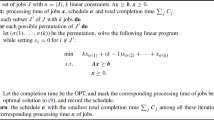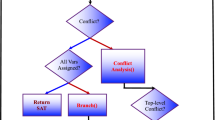Abstract
Satisfiability problems are of importance for many practical problems. They are NP-complete problems. However, some instances of the SAT problem can be solved efficiently. This paper reports on a study concerning the behaviour of a variety of algorithmic approaches to this problem tested on a set of problems collected at FAW. The results obtained give a lot of insight into the algorithms and problems, yet also show some general technical and methodological problems associated with such comparisons.
Similar content being viewed by others
References
R. Brayton, G.D. Hachtel, C.T. McMullen and A.L. Sangiovanni-Vincentelli,Logic Minimization Algorithms for VLSI Synthesis (Kluwer Academic, 1984).
R.E. Bryant, Graph based algorithms for Boolean function manipulation, IEEE Trans. Comp. C-35 (1986).
W. Buettner and H. Simonis, Embedding Boolean expressions into logic programming, J. Symbolic Comp. (1987) 191 205.
M. Buro and H. Kleine-Bünig, Report on a SAT Competition, Bericht Nr. 110, Reihe Informatik, Universität Paderborn (1992).
J. Cohen, Constraint logic programming languages, Commun. ACM 33 (1990) 52–68.
A. Colmerauer, An introduction to Prolog III. Commun. ACM 33 (1990) 69–90.
ESPRIT P1106 Consortium. Final Report Part 1 (January 1990).
K. Estenfeld et al., PROLOG-XT, Corporate Research and Development, Research Laboratories for Applied Computer Science and Software Information and Knowledge Processing, Siemens Confidential.
F. Harche, J.N. Hooker and G.L. Thompson. A computational study of satisfiability algorithms for propositional logic, Management Science Research Report MSRR-567, Carnegie Mellon University (1991).
J.N. Hooker, A quantitative approach to logical inference, Dec. Support Syst. 4 (1988) 45–69.
J.N. Hooker and C. Fedjki, Branch-and-cut solution of inference problems in propositional logic, Ann. Math. Art. Int. 1 (1990) 123–139.
R.G. Jeroslow and J. Wang, Solving propositional satisfiability problems, Ann. Math. Art. Int. 1 (1990) 167–187.
U. Martin and T. Nipkow, Boolean unification - the story so far, J. Symbolic Comp. 7 (1989) 275–293.
M. Meier et al., SEPIA — an extendible Prolog system,Proc. 11th World Computer Progress IFIP'89, San Francisco (August, 1989).
G. Patrizi, The equivalence of an LCP to a parametric linear program with a scalar parameter, Euro. J. Oper. Res. 51 (1991) 367–386.
S. Rudeanu,Boolean Functions and Equations (North-Holland, Amsterdam, London, 1974).
K. Sakai and Y. Sato, Boolean Groebner bases, Technical report, ICOT, Tokyo, Japan (June 1988).
U. Schöning,Logik für Informatiker, Reihe Informatik, Bd. 56, 2. Auflage (BI-Wissenschaftsverlag, Mannheim, Wien, Zürich, 1989).
P. Siegel, Represèntation et utilisation de la connaissance en calcul propositionnel, Thèse de doctorat d'Etat, GIA, Faculté des Sciences de Luminy, Université Aix-Marseille (July 1987).
J.H. Siekmann, Universal unification,7th Int. Conf. on Automated Deduction, Napa Valley, CA (1984) pp. 1–42.
H. Simonis and M. Dincbas, Propositional calculus problems in CHIP, in:Proc. 2nd Int. Conf. on Algebraic and Logic Programming (1990).
C. Spera, Computational results for solving large general satisfiability problems, University of Siena, Department of Mathematics, Rapporto Matematico N. 222 (August 1990).
G.J. Sussman and G.L. Steele, CONSTRAINTS — a language for expressing almost-hierarchical descriptions, Art. Int. J. 14 (1980).
K. Trümper and F.J. Radermacher, Analyse der Leistungsfähigkeit eines neuen Systems zur Auswertung aussagenlogischer Probleme, FAW-TR-90003, Version 1 (February 1990).
P. Van Hentenryck,Constraint Satisfaction in Logic Programming, Logic Programming Series (MIT Press, Cambridge, MA, 1989).
J. Wang, Rule-based expert systems and discrete optimization, Thesis, Georgia Institute of Technology (July 1990).
L. Wos, R. Overbeek, E. Lusk and J. Boyle,Automatical Reasoning (Prentice-Hall, Englewood Cliffs, NJ, 1984).
Author information
Authors and Affiliations
Rights and permissions
About this article
Cite this article
Mayer, J., Mitterreiter, I. & Josef Radermacher, F. Running time experiments on some algorithms for solving propositional satisfiability problems. Ann Oper Res 55, 139–178 (1995). https://doi.org/10.1007/BF02031719
Issue Date:
DOI: https://doi.org/10.1007/BF02031719




